The Relationship between the Wintertime Cold Extremes over East Asia with Large-Scale Atmospheric and Oceanic Teleconnections
Abstract
1. Introduction
2. Data and Methodology
2.1. Data
2.2. Methodology
3. Results
3.1. The Mean Winter Climatology within East Asia during the Positive or Negative Phase of Low-Frequency Large-Scale Circulations
3.1.1. The Tmin Anomalies
3.1.2. The Tmin Extremes
3.1.3. The Z500 and SST Anomalies
3.2. Individual Cases Associated with the Large-Scale Teleconnections
3.2.1. The Tmin Extremes in the Pattern of the Individual Cases
3.2.2. The Possible Formation Mechanisms of Cold Extremes for the Individual Cases
4. Summary and Discussions
Author Contributions
Funding
Conflicts of Interest
References
- Barnston, A.G.; Livezey, R.E. Classification, seasonality and persistence of low-frequency atmospheric circulation patterns. Mon. Weather Rev. 1987, 115, 1083–1126. [Google Scholar] [CrossRef]
- Lim, Y.-K.; Kim, H.-D. Impact of the dominant large-scale teleconnections on winter temperature variability over East Asia. J. Geophys. Res. Atmos. 2013, 118, 7835–7848. [Google Scholar] [CrossRef]
- Yuan, J.; Tan, B.; Feldstein, S.B.; Lee, S. Wintertime North Pacific teleconnection patterns: Seasonal and interannual variability. J. Clim. 2015, 28, 8247–8263. [Google Scholar] [CrossRef]
- Harzallah, A.; Sadourny, R. Internal versus SST-forced atmospheric variability as simulated by an atmospheric general-circulation model. J. Clim. 1995, 8, 474–495. [Google Scholar] [CrossRef]
- Tan, B.; Chen, W. Progress in the study of the dynamics of extratropical atmospheric teleconnection patterns and their impacts on East Asian climate. Acta Meteorol. Sin. 2014, 72, 908–925. [Google Scholar] [CrossRef]
- Wallace, J.M.; Gutzler, D.S. Teleconnections in the geopotential height field during the northern hemisphere winter. Mon. Weather Rev. 1981, 109, 784–812. [Google Scholar] [CrossRef]
- Park, H.-J.; Ahn, J.-B. Combined effect of the Arctic Oscillation and the Western Pacific Pattern on East Asia winter temperature. Clim. Dyn. 2016, 46, 3205–3221. [Google Scholar] [CrossRef]
- Gong, D.Y.; Wang, S.W.; Zhu, J.H. East Asian winter monsoon and Arctic Oscillation. Geophys. Res. Lett. 2001, 28, 2073–2076. [Google Scholar] [CrossRef]
- Chen, W.; Lan, X.; Wang, L.; Ma, Y. The combined effects of the ENSO and the Arctic Oscillation on the winter climate anomalies in East Asia. Chin. Sci. Bull. 2013, 58, 1355–1362. [Google Scholar] [CrossRef]
- Zhang, R.H.; Sumi, A.; Kimoto, M. Impact of El Nino on the East Asian monsoon: A diagnostic study of the 86/87 and 91/92 events. J. Meteorol. Soc. Jpn. 1996, 74, 49–62. [Google Scholar] [CrossRef]
- Wang, S.; Huang, J.; He, Y.; Guan, Y. Combined effects of the Pacific Decadal Oscillation and El Nino-Southern Oscillation on global land dry-wet changes. Sci. Rep. 2014, 4, 6651. [Google Scholar] [CrossRef]
- Wang, H.; He, S. Weakening relationship between East Asian winter monsoon and ENSO after mid-1970s. Chin. Sci. Bull. 2012, 57, 3535–3540. [Google Scholar] [CrossRef]
- Liu, Y.; Wang, L.; Zhou, W.; Chen, W. Three Eurasian teleconnection patterns: Spatial structures, temporal variability, and associated winter climate anomalies. Clim. Dyn. 2014, 42, 2817–2839. [Google Scholar] [CrossRef]
- Sun, Y.; Xu, H.; Deng, J. Interdecadal variation in Pacific-Japan teleconnection patterns and possible causes. J. Atmos. Sci. 2014, 38, 1055–1065. [Google Scholar]
- Sun, J.; Wu, S.; Ao, J. Role of the North Pacific sea surface temperature in the East Asian winter monsoon decadal variability. Clim. Dyn. 2016, 46, 3793–3805. [Google Scholar] [CrossRef]
- Chen, S.; Chen, W.; Wei, K. Recent trends in winter temperature extremes in eastern China and their relationship with the Arctic Oscillation and ENSO. Adv. Atmos. Sci. 2013, 30, 1712–1724. [Google Scholar] [CrossRef]
- Huang, R.; Chen, J.; Wang, L.; Lin, Z. Characteristics, processes, and causes of the spatio-temporal variabilities of the East Asian monsoon system. Adv. Atmos. Sci. 2012, 29, 910–942. [Google Scholar] [CrossRef]
- Loikith, P.C.; Broccoli, A.J. Characteristics of observed atmospheric circulation patterns associated with temperature extremes over North America. J. Clim. 2012, 25, 7266–7281. [Google Scholar] [CrossRef]
- Hsu, H.H.; Chen, Y.L.; Kau, W.S. Effects of atmosphere-ocean interaction on the interannual variability of winter temperature in Taiwan and East Asia. Clim. Dyn. 2001, 17, 305–316. [Google Scholar] [CrossRef]
- Loikith, P.C.; Broccoli, A.J. The influence of recurrent modes of climate variability on the occurrence of winter and summer extreme temperatures over North America. J. Clim. 2014, 27, 1600–1618. [Google Scholar] [CrossRef]
- Zhu, Q.; Lin, J.; Shou, S.; Tang, D. Principles and Methods of Meteorology; China Meteorological Press: Beijing, China, 2000. [Google Scholar]
- Frankignoul, C. Sea surface temperature anamalies, planetary waves, and air-sea feedback in the middle latitudes. Rev. Geophys. 1985, 23, 357–390. [Google Scholar] [CrossRef]
- Li, Y.; He, J.; Jiang, A.; Zhou, B. Circulation structure features of Western Pacific teleconnection pattern in winter and its relation with China’s temperature and precipitation in winter. J. Meteorol. Sci. 2007, 27, 119–125. [Google Scholar]
- Wu, B.Y.; Wang, J. Winter Arctic Oscillation, Siberian High and East Asian winter monsoon. Geophys. Res. Lett. 2002, 29. [Google Scholar] [CrossRef]
- Li, F.; Wang, H.J.; Gao, Y.Q. On the strengthened relationship between the East Asian winter monsoon and Arctic Oscillation: A comparison of 1950-70 and 1983-2012. J. Clim. 2014, 27, 5075–5091. [Google Scholar] [CrossRef]
- Linkin, M.E.; Nigam, S. The North Pacific Oscillation-West Pacific teleconnection pattern: Mature-phase structure and winter impacts. J. Clim. 2008, 21, 1979–1997. [Google Scholar] [CrossRef]
- Yeh, S.-W.; Kang, Y.-J.; Noh, Y.; Miller, A.J. The North Pacific climate transitions of the winters of 1976/77 and 1988/89. J. Clim. 2011, 24, 1170–1183. [Google Scholar] [CrossRef]
- Xu, P.; Feng, J.; Chen, W. Asymmetric role of ENSO in the link between the East Asian winter monsoon and the following summer monsoon. J. Atmos. Sci. 2016, 40, 831–840. [Google Scholar]
- Li, C.; Wettstein, J.J. Thermally driven and eddy-driven jet variability in reanalysis. J. Clim. 2012, 25, 1587–1596. [Google Scholar] [CrossRef]
- Tanaka, S.; Nishii, K.; Nakamura, H. Vertical structure and energetics of the western pacific teleconnection pattern. J. Clim. 2016, 29, 6597–6616. [Google Scholar] [CrossRef]
- Feng, J.; Chen, W.; Li, Y. Asymmetry of the winter extra-tropical teleconnections in the northern hemisphere associated with two types of ENSO. Clim. Dyn. 2017, 48, 2135–2151. [Google Scholar] [CrossRef]
- Feng, J.; Chen, W.; Tam, C.Y.; Zhou, W. Different impacts of El Nino and El Nino Modoki on China rainfall in the decaying phases. Int. J. Climatol. 2011, 31, 2091–2101. [Google Scholar] [CrossRef]
- Feng, J.A.; Wang, L.; Chen, W.; Fong, S.K.; Leong, K.C. Different impacts of two types of Pacific Ocean warming on Southeast Asian rainfall during boreal winter. J. Geophys. Res. Atmos. 2010, 115. [Google Scholar] [CrossRef]
- Yang, S.; Jiang, X.W. Prediction of eastern and central Pacific ENSO events and their impacts on East Asian climate by the NCEP climate forecast system. J. Clim. 2014, 27, 4451–4472. [Google Scholar] [CrossRef]
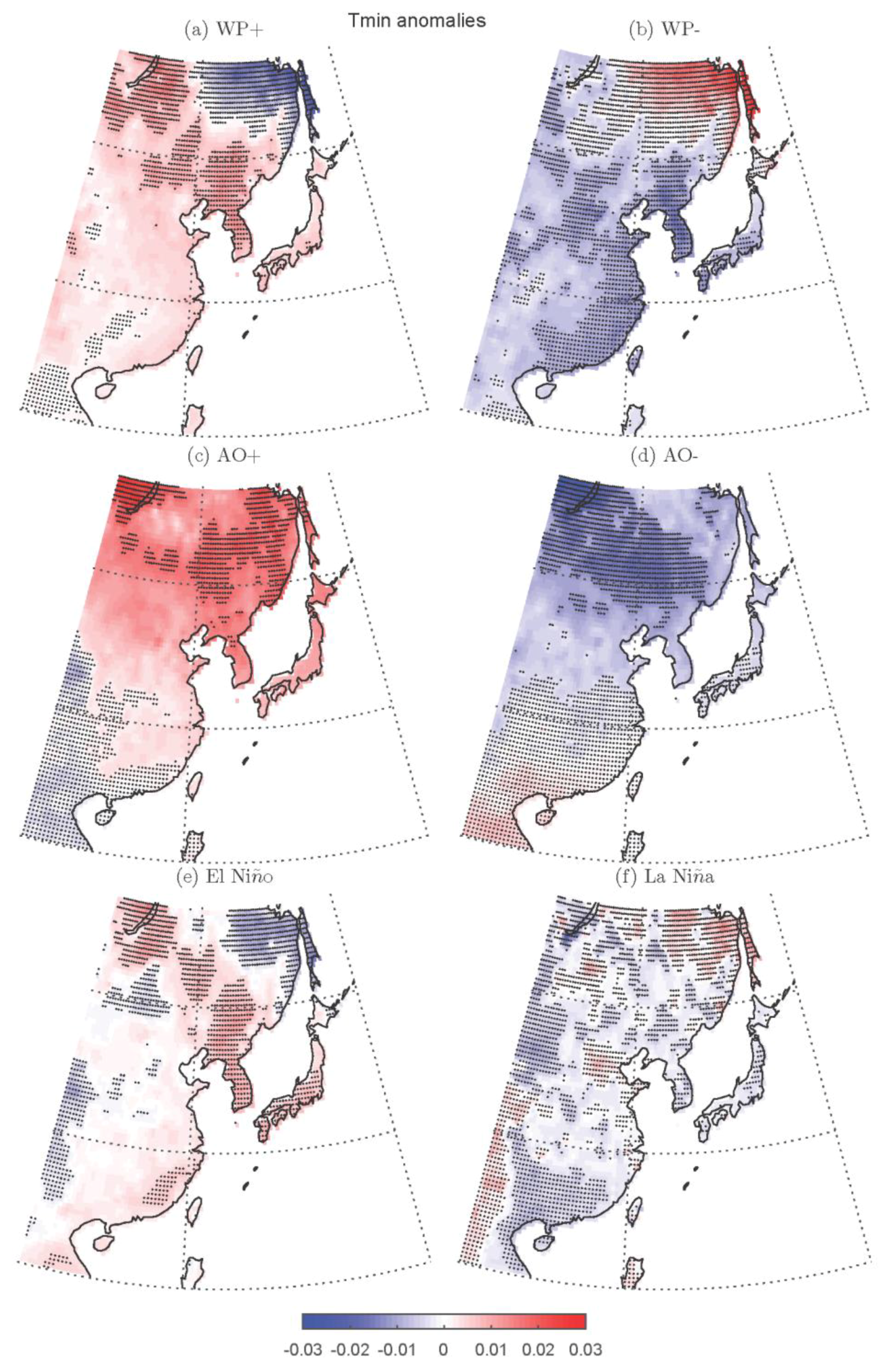
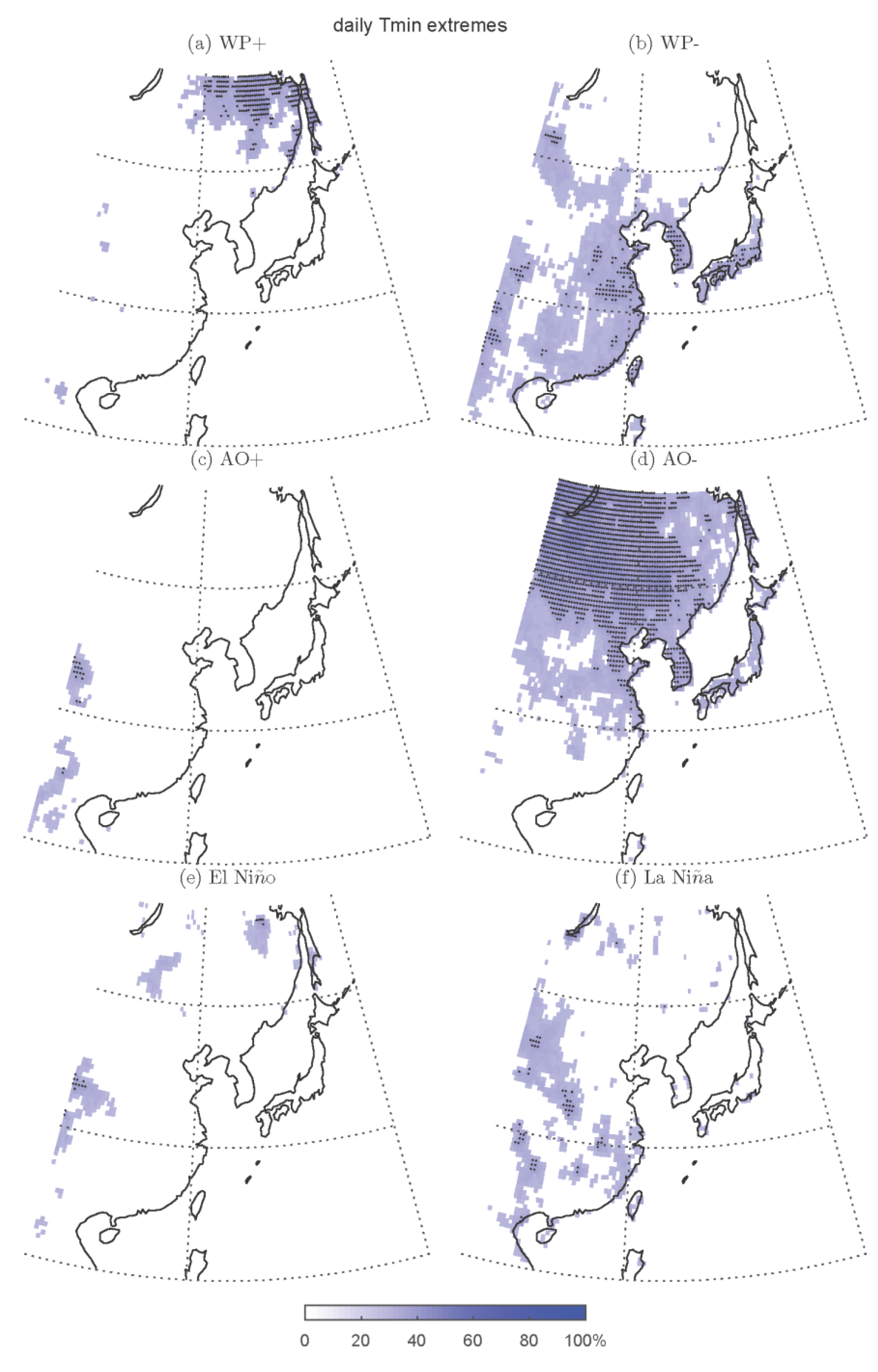

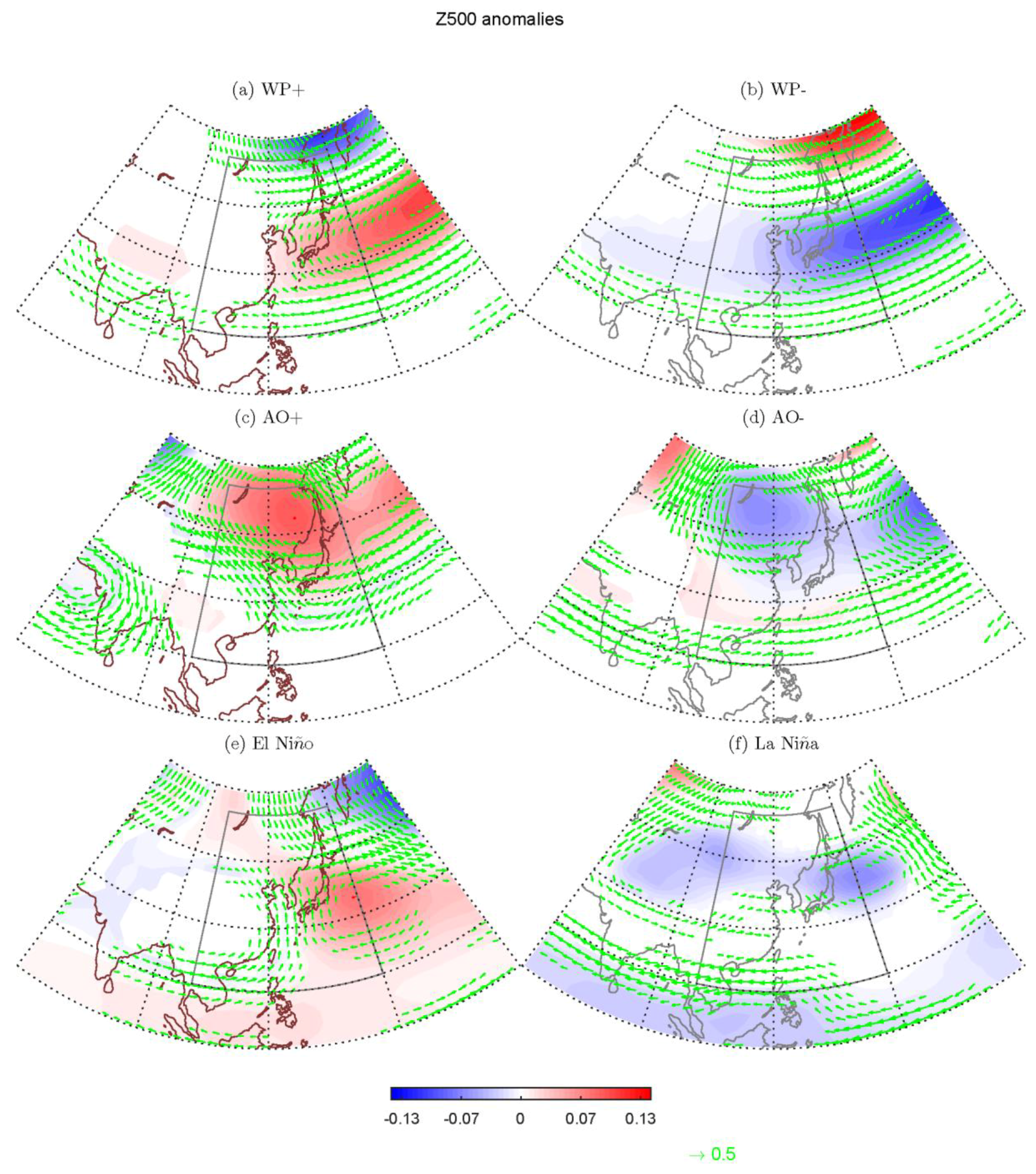
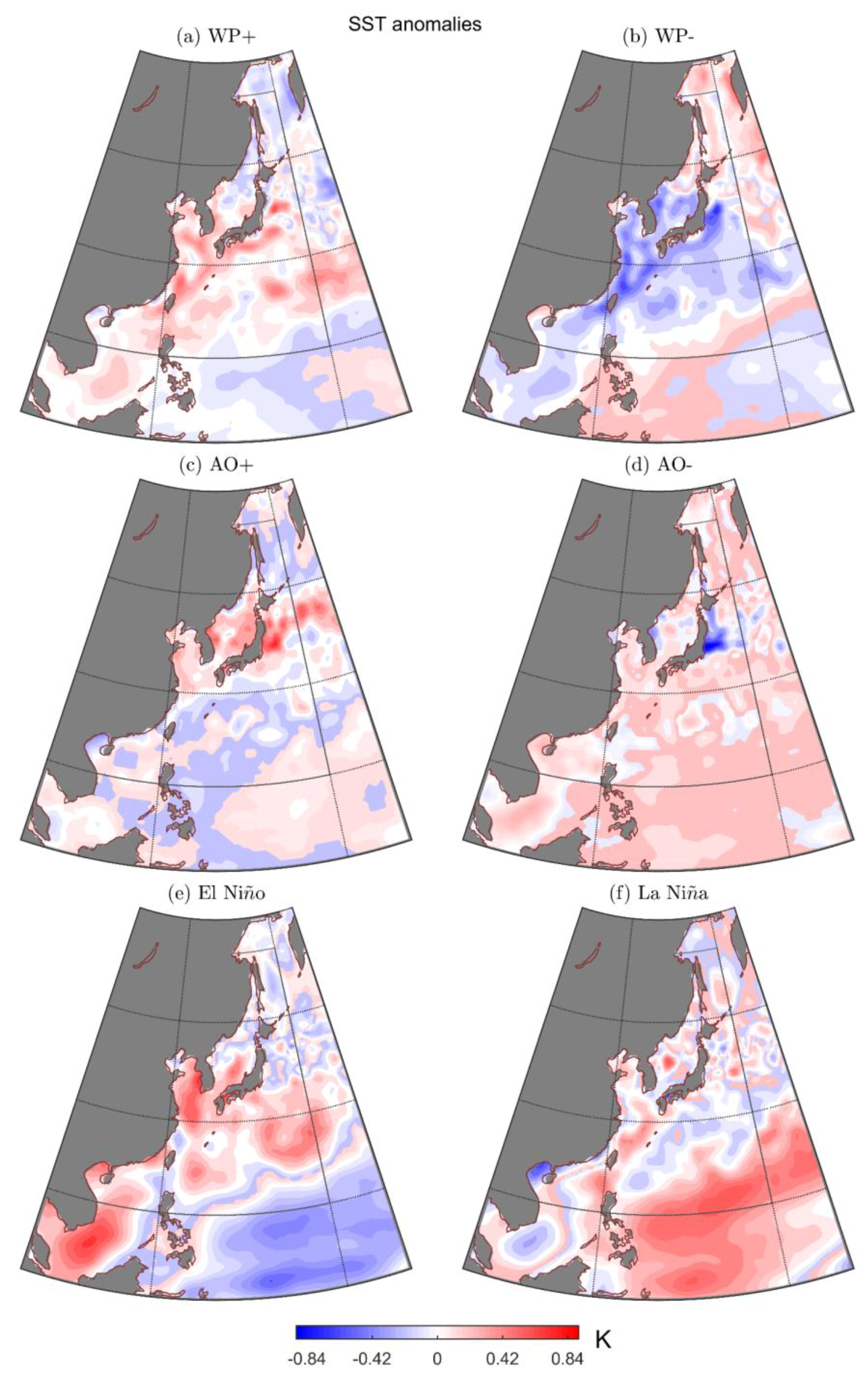

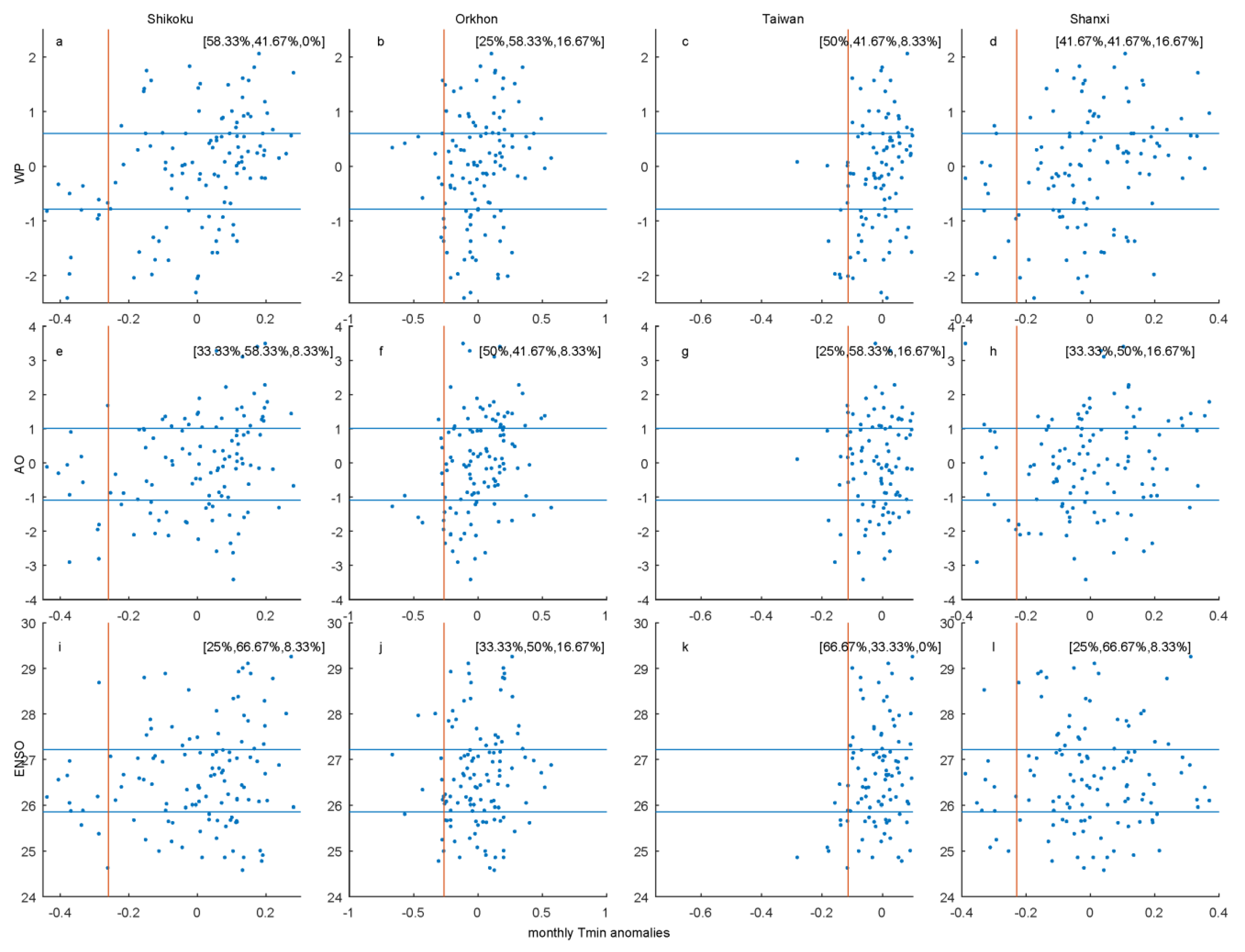
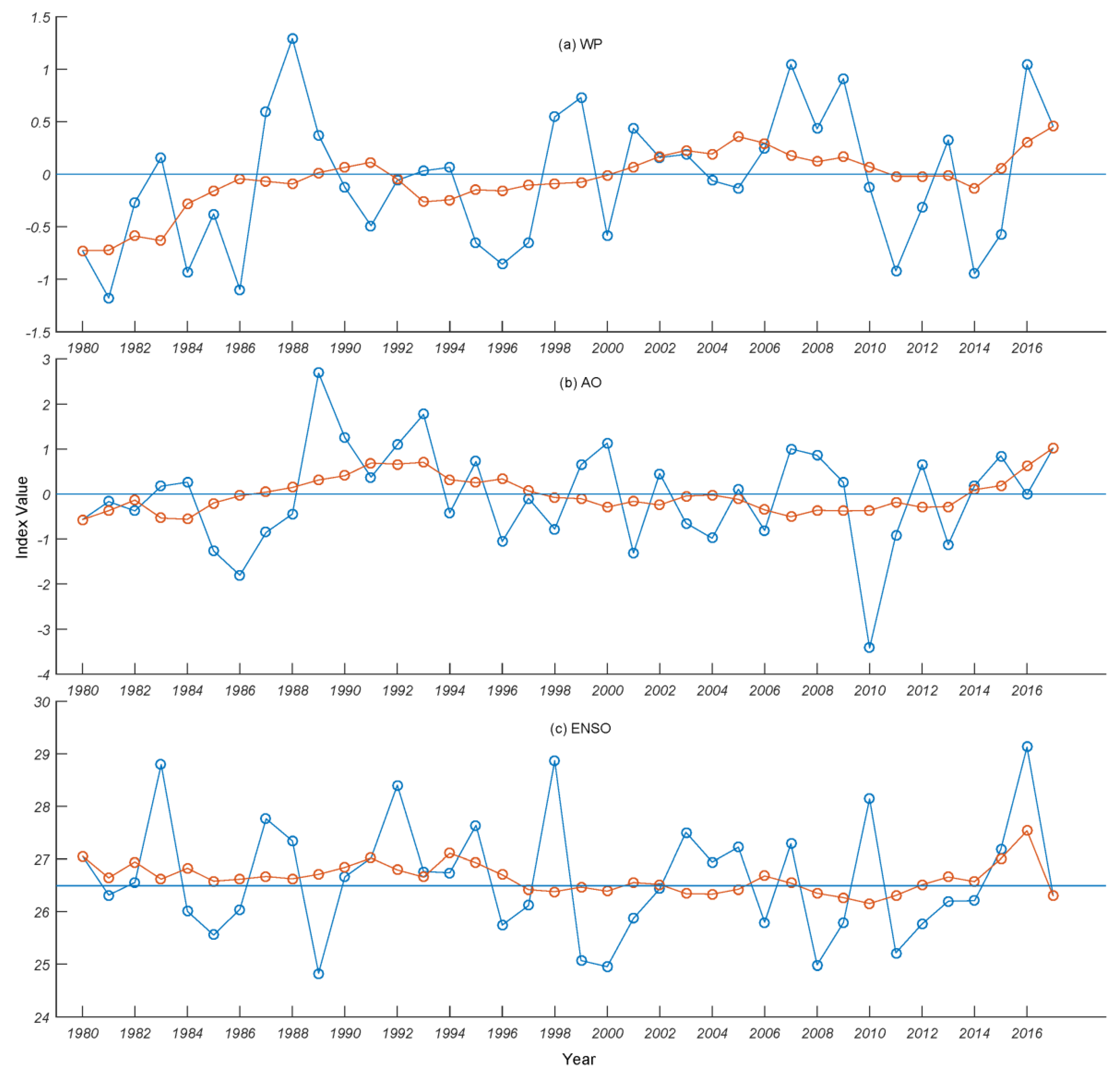

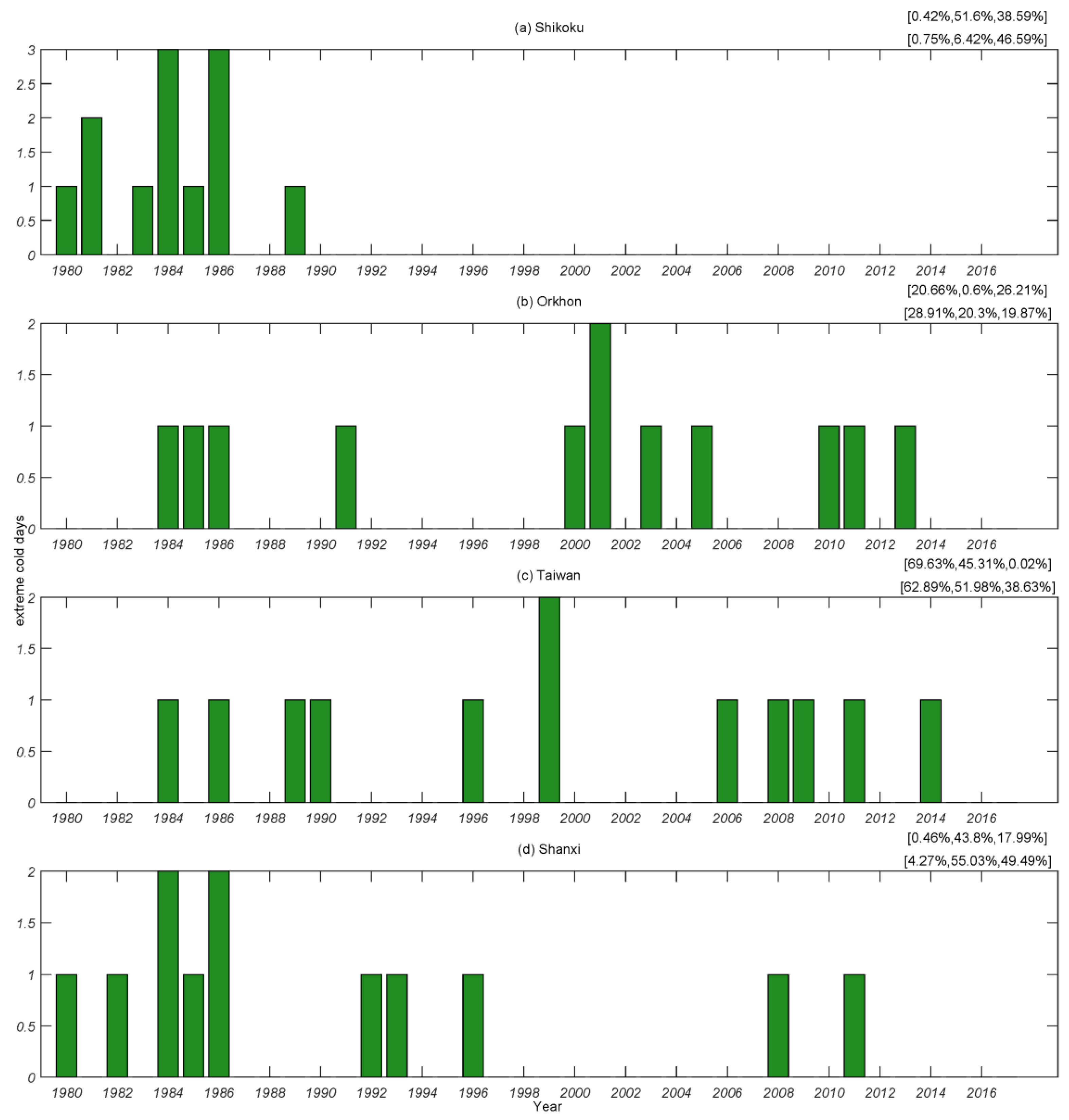
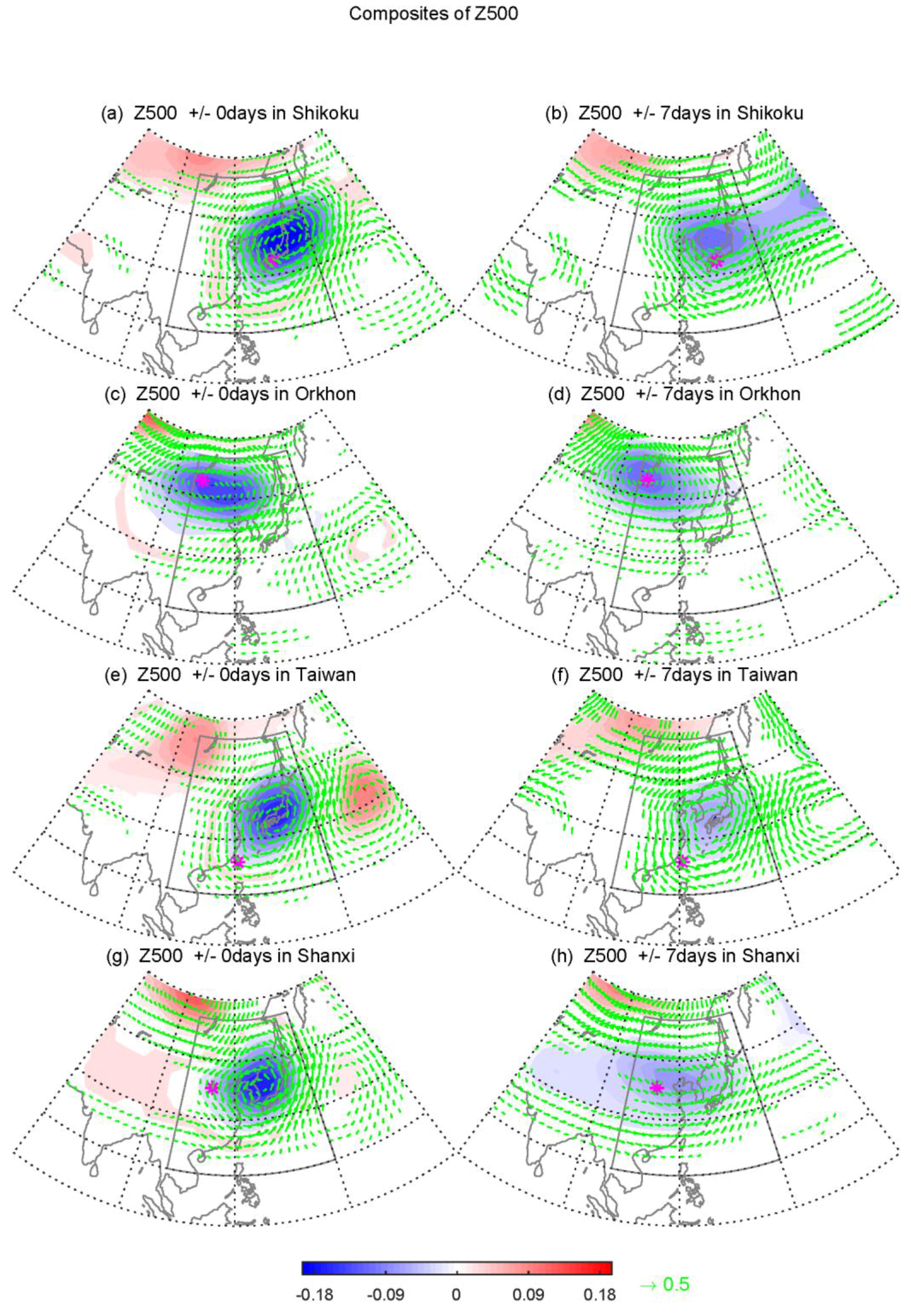
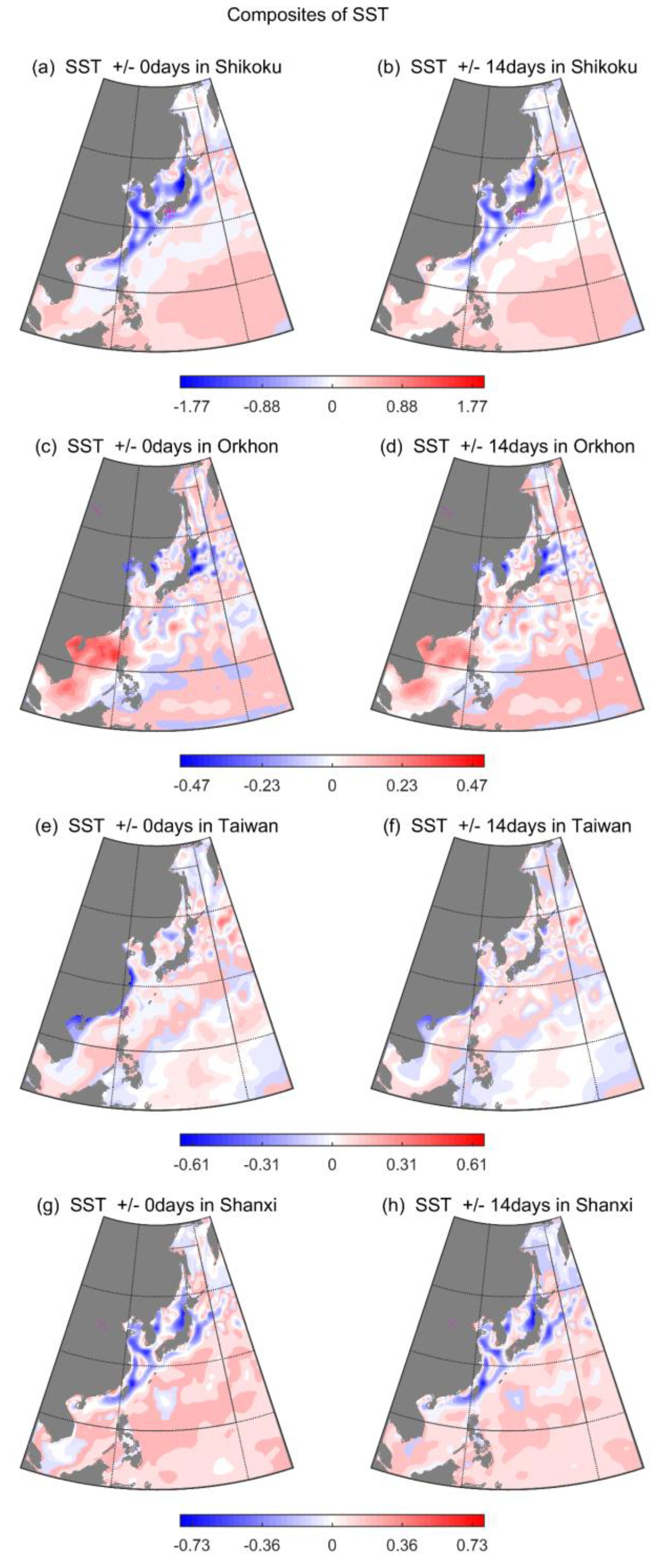

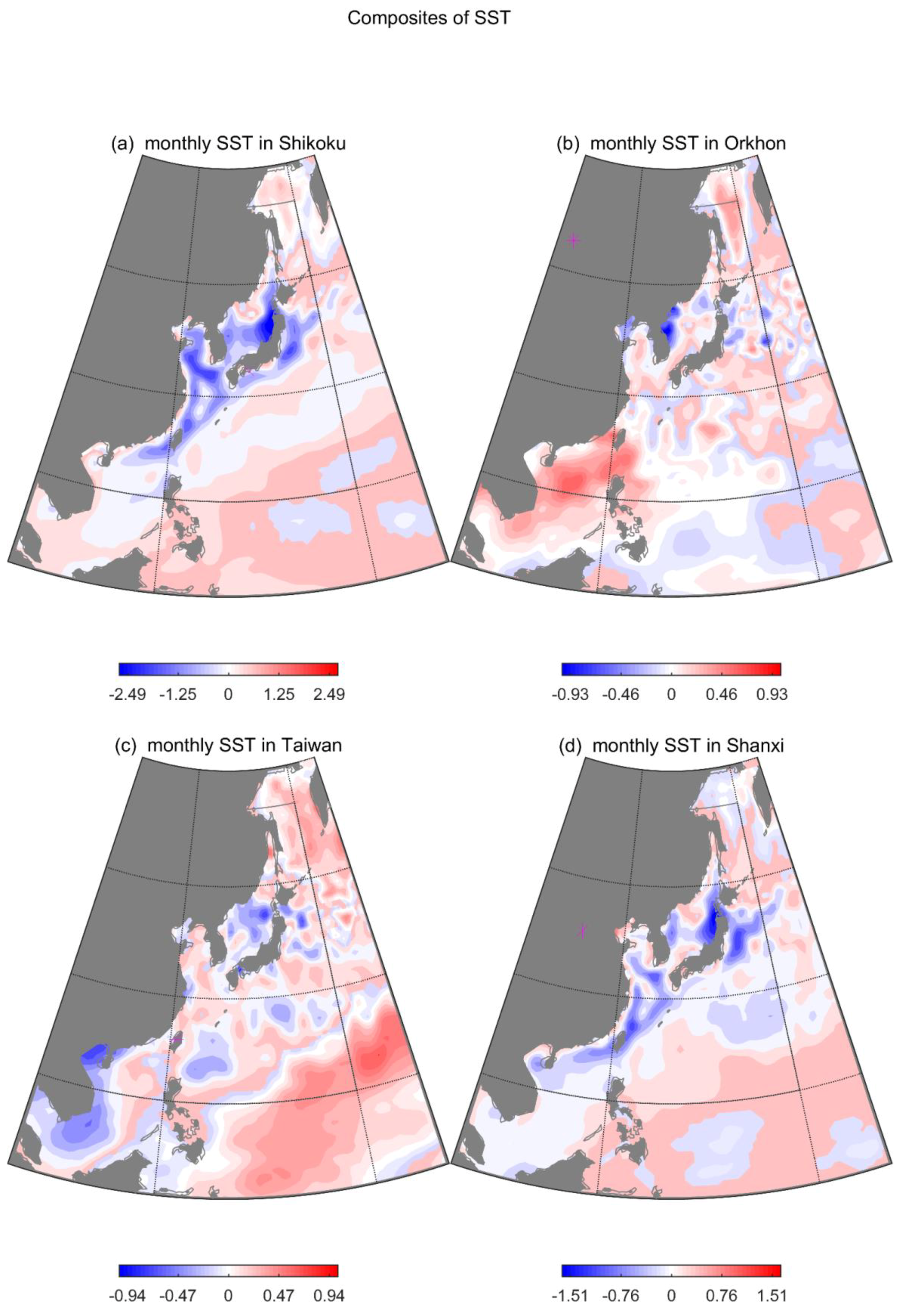
© 2019 by the authors. Licensee MDPI, Basel, Switzerland. This article is an open access article distributed under the terms and conditions of the Creative Commons Attribution (CC BY) license (http://creativecommons.org/licenses/by/4.0/).
Share and Cite
Yang, Y.; Xie, N.; Gao, M. The Relationship between the Wintertime Cold Extremes over East Asia with Large-Scale Atmospheric and Oceanic Teleconnections. Atmosphere 2019, 10, 813. https://doi.org/10.3390/atmos10120813
Yang Y, Xie N, Gao M. The Relationship between the Wintertime Cold Extremes over East Asia with Large-Scale Atmospheric and Oceanic Teleconnections. Atmosphere. 2019; 10(12):813. https://doi.org/10.3390/atmos10120813
Chicago/Turabian StyleYang, Ye, Naru Xie, and Meng Gao. 2019. "The Relationship between the Wintertime Cold Extremes over East Asia with Large-Scale Atmospheric and Oceanic Teleconnections" Atmosphere 10, no. 12: 813. https://doi.org/10.3390/atmos10120813
APA StyleYang, Y., Xie, N., & Gao, M. (2019). The Relationship between the Wintertime Cold Extremes over East Asia with Large-Scale Atmospheric and Oceanic Teleconnections. Atmosphere, 10(12), 813. https://doi.org/10.3390/atmos10120813




